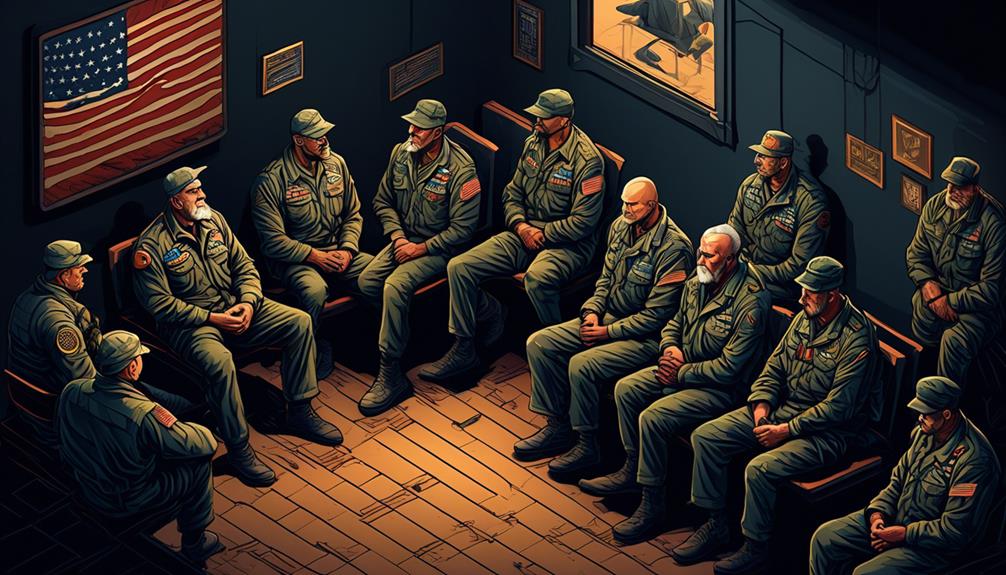As a writer who has delved into the statistics surrounding PTSD in veterans, I can confidently say that the impact of this condition on our servicemen and women is staggering.
The numbers paint a stark picture, revealing the prevalence of lifetime PTSD in US veterans to be 8.0%, with a current PTSD prevalence of 4.8%. These figures represent the tip of the iceberg, hinting at the profound and far-reaching effects of PTSD on veterans' lives.
But what lies beneath these statistics? What are the specific factors contributing to the prevalence of PTSD in our veteran population, and what can be done to address this pressing issue?
Key Takeaways
- The lifetime prevalence of PTSD in US veterans is 8.0%, with a current prevalence of 4.8%.
- Female veterans have a higher lifetime prevalence of PTSD at 13% compared to 6% in male veterans.
- PTSD prevalence in the past year is 11% in women and 5% in men.
- Prevalence of current war-zone-related PTSD is higher in veterans of the Persian Gulf War and OEF/OIF compared to WWII/Korean War and Vietnam War veterans.
Prevalence of PTSD in Veterans
The prevalence of PTSD in veterans varies significantly based on gender and the era in which they served. Higher rates of PTSD are observed among female veterans and those who served in more recent conflicts.
Among veterans, the lifetime prevalence of PTSD is 7%. However, this rate increases to 13% for female veterans and decreases to 6% for male veterans. In terms of past-year prevalence, PTSD is also higher in women at 11% compared to 5% in men.
When looking at specific eras, the prevalence of current and lifetime PTSD is lower in WWII/Korean War and Vietnam War veterans compared to those who served in the Persian Gulf War and OEF/OIF. For example, the prevalence of current war-zone-related PTSD is 4% in men and 6% in women for Vietnam veterans. The prevalence of lifetime war-zone-related PTSD is 17% in men and 15% in women for Vietnam veterans.
These statistics shed light on the varying prevalence of PTSD among veterans and emphasize the need for tailored support and resources based on gender and the specific era in which they served.
Impact of PTSD on Veterans

Experiencing PTSD can significantly impact veterans' mental health and overall well-being, leading to a range of challenges and difficulties in their daily lives. It's important to understand the various ways in which PTSD affects veterans:
- Comorbid Disorders: PTSD is often associated with other mental health issues such as substance use disorder, mood disorder, anxiety disorder, and personality disorder. This can lead to increased impairment of functioning and greater health care utilization for physical problems.
- Treatment Delays: Many veterans face delays in accessing mental health treatment, often significantly longer than civilians. Delayed treatment can have negative consequences for veterans' mental health and well-being.
- Quality of Life: PTSD has a significant impact on the quality of life of veterans, resulting in lower overall quality of life, interference with daily functioning and relationships, and higher rates of comorbid mental health conditions such as depression and substance use disorders.
Understanding these impacts is crucial in developing effective support systems and interventions to help veterans manage and overcome the challenges posed by PTSD.
PTSD Rates by War Era
When considering PTSD rates by war era, it's crucial to acknowledge the significant impact of the Vietnam War, where a high percentage of veterans have experienced PTSD.
Additionally, it's important to examine the trends in PTSD rates among veterans of the Post-9/11 era, such as those who served in Operation Enduring Freedom and Operation Iraqi Freedom.
These insights can provide valuable understanding of the long-term effects of combat experiences on veterans from different war eras.
Vietnam War PTSD Rates
During the Vietnam War, the prevalence of PTSD among male veterans was 30.9%, while for female veterans, it was 26.9%. This has had a lasting impact on the mental well-being of those who served. It's important to understand the factors contributing to these statistics:
- The intensity of combat experiences and prolonged exposure to traumatic events during the war.
- The lack of social support and understanding of mental health at the time.
- The challenges faced upon returning home, including the lack of proper reintegration programs and the stigma surrounding mental health.
These factors have contributed to the high prevalence of PTSD among Vietnam War veterans. Understanding these complexities is crucial in providing the necessary support and care for our veterans.
Post-9/11 PTSD Trends
Analyzing the PTSD rates by war era reveals significant differences in prevalence among veterans, particularly in comparing WWII/Korean War and Vietnam War veterans to Persian Gulf War and OEF/OIF veterans.
Among Iraq and/or Afghanistan Veterans, the prevalence of PTSD in 2021 is 24% overall, with a slightly higher rate in women. Lifetime PTSD prevalence is 23% in VA users and 7% in non-VA users. For current PTSD, the rates are 13% in VA users and 4% in non-VA users.
In comparison, the current war-zone-related PTSD prevalence is 4% in men and 6% in women for Vietnam Veterans. These statistics clearly indicate an escalation in PTSD rates among more recent war eras, emphasizing the importance of understanding and addressing the mental health needs of Post-9/11 veterans.
Non-Combat Causes of PTSD

Experiencing a sudden death of a close friend can also trigger PTSD in veterans, highlighting the diverse non-combat causes of this condition. This non-combat event can lead to significant emotional distress and trauma, impacting the mental well-being of veterans. Additionally, repeated or extreme exposure to traumatic events during service, such as natural disasters or accidents, can contribute to the development of PTSD among military personnel. These events, although not directly related to combat, can still have a profound impact on the mental health of veterans.
Moreover, sexual assault and harassment within the military context can be significant non-combat causes of PTSD among veterans, affecting both men and women. It's important to note that more than half of veterans who experienced military sexual trauma are men, highlighting the non-combat nature of the trauma. As a response to this, the U.S. Department of Defence prioritizes sexual assault prevention, and VA health care facilities offer services for veterans who were sexually assaulted, recognizing the importance of addressing non-combat causes of PTSD.
Associated Health Risks for Veterans With PTSD

After examining the non-combat causes of PTSD in veterans, it becomes evident that the associated health risks for veterans with PTSD are multifaceted and impactful on their overall well-being and functioning.
| Health Risk | Impact |
|---|---|
| Substance Use Disorders | Over 20% of veterans with PTSD struggle with substance abuse, exacerbating their mental and physical health. |
| Comorbid Mental Illnesses | Roughly 80% of people with PTSD have at least one other mental illness, often leading to depression and anxiety. |
| Increased Mortality | PTSD is associated with increased overall mortality and mortality due to accidental causes, highlighting severe health risks. |
| Reduced Quality of Life | Veterans with PTSD often experience a decrease in their overall functioning and well-being, impacting their daily lives. |
| Greater Health Care Utilization for Physical Problems | PTSD is linked with a greater likelihood of comorbid disorders, leading to increased health care utilization. |
These health risks emphasize the critical need for timely and adequate mental health care for veterans with PTSD. Effective treatment not only improves their quality of life but also helps them regain functioning and well-being.
Effective PTSD Treatment Approaches

Effective treatment approaches for PTSD include cognitive-behavioral therapy (CBT), eye movement desensitization and reprocessing (EMDR), medications like selective serotonin reuptake inhibitors (SSRIs), group therapy, and complementary therapies such as yoga and meditation.
Personally, I found cognitive-behavioral therapy (CBT) to be incredibly helpful in addressing and changing negative thought patterns and behaviors associated with my PTSD. Additionally, EMDR provided a structured approach to reprocessing traumatic memories, reducing their impact. Medications, such as SSRIs, helped alleviate some of the anxiety and depression symptoms. Group therapy, where I could share experiences and receive validation, was crucial for my recovery.
Notably, complementary therapies like yoga and meditation offered me tools for managing my symptoms and promoting relaxation. In my experience, these treatments were most effective when used in combination. It's important for individuals to work with their healthcare providers to find the right combination of treatments that work best for them. Each person's experience with PTSD is unique, and finding the right approach may take time and patience.
Additional Research and Resources

I'll discuss the research findings and support services available for veterans struggling with PTSD.
Understanding the latest research findings can help us tailor interventions to better support veterans from different war eras.
Additionally, accessing support services is crucial for veterans in crisis or seeking disability claims for PTSD.
Research Findings
Research findings on PTSD in veterans continue to drive the development of personalized treatments and innovative approaches to improve the quality of life for those affected. Based on current research, it's evident that PTSD prevalence varies across different war eras and among different groups of veterans, highlighting the need for targeted interventions and support.
Furthermore, understanding the impact of PTSD on the quality of life of veterans is crucial, as it's associated with comorbid mental health conditions, functional impairments, and increased risk of mortality. Additionally, effective treatment for PTSD can significantly improve the quality of life for veterans, emphasizing the importance of developing and providing accessible treatment options.
Ongoing research efforts are focused on developing personalized treatments for PTSD, exploring innovative approaches such as virtual reality therapy, neurofeedback, and ketamine infusion therapy, and increasing collaboration between mental health professionals and primary care providers to enhance PTSD care.
Support Services
As we delve into the crucial area of 'Support Services' (Additional Research and Resources), it becomes essential to explore additional resources on how PTSD affects veterans.
| Resource | Description |
|---|---|
| PTSD and Disability Claims | Access crucial information on filing disability claims related to PTSD. |
| C&P Exam for PTSD | Learn about the Compensation and Pension exam process for PTSD. |
| PTSD and Depression Link | Understand the correlation between PTSD and depression, and how to seek help. |
| Benefits of Meditation for PTSD | Discover the benefits of meditation in managing PTSD symptoms and improving overall well-being. |
These resources aim to provide comprehensive support and assistance to veterans dealing with PTSD.
Frequently Asked Questions
How Does the Prevalence of PTSD in Veterans Compare to the General Population?
The prevalence of PTSD in veterans is higher than in the general population. It's important to recognize the impact this has on veterans and ensure they have access to the support and resources they need.
Are There Any Specific Demographic Factors That Contribute to Higher Rates of PTSD in Veterans?
Yes, specific demographic factors contribute to higher rates of PTSD in veterans, such as gender, era of service, and use of VA services. These factors significantly impact the prevalence of PTSD among veterans.
What Are the Long-Term Economic and Social Impacts of PTSD on Veterans and Their Families?
The long-term economic and social impacts of PTSD on veterans and their families are significant. It can lead to unemployment, strain family relationships, and increase healthcare costs, impacting both financial stability and community integration.
How Do Non-Combat Causes of PTSD, Such as Military Sexual Trauma, Differ in Their Effects on Veterans Compared to Combat-Related PTSD?
Dealing with non-combat causes like military sexual trauma, I've seen unique psychological effects in veterans. Feelings of betrayal, powerlessness, and mistrust can make forming relationships tough, impacting daily life and mental health treatment.
What Are the Current Gaps in Research on PTSD in Veterans, and What Areas Need Further Exploration?
I'll address current research gaps on PTSD in veterans. Understanding non-combat traumas' impact, identifying risk factors, and evaluating innovative treatments are essential. Further exploration is needed to improve care and support for veterans with PTSD.
Conclusion
As a veteran, it's clear that PTSD is a significant issue that affects many of us. The statistics show just how widespread it is, and the impact it can have on our lives.
But there's hope – effective treatment approaches are available, and it's important to seek help. We've been through tough times before, and we can overcome this too.
Let's continue to support each other and work towards a brighter future.










